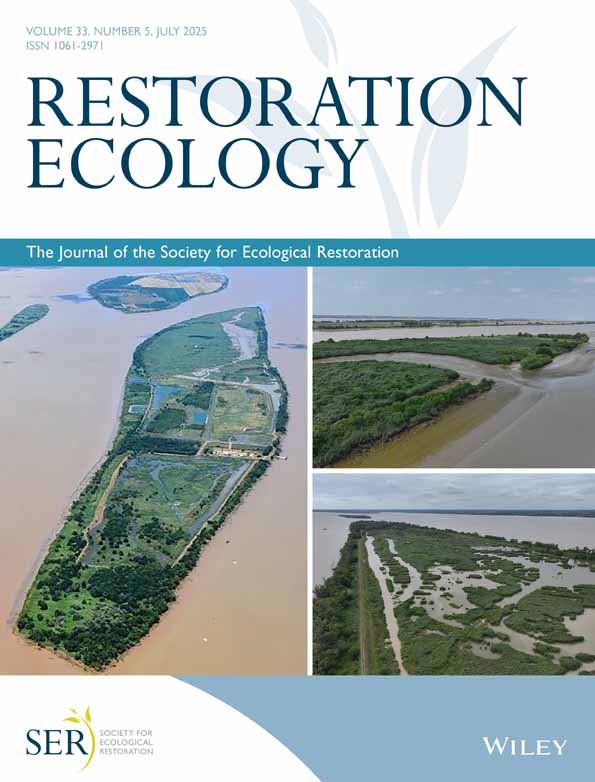Human development and restoration-related public policies are positively related at the global level
Abstract
Introduction
Ecological restoration is essential to reverse the extensive forest loss caused by human development over the past three decades. Public policies play a critical role in balancing environmental protection with development. We review restoration policies and explore the relationship of Human Development Index (HDI) and forest cover loss in 2000–2020, focusing on monitoring plans, native species, and agroforestry systems.
Objectives
We test the hypothesis that more developed countries have more restoration policies and lower deforestation rates.
Methods
We analyzed 414 policies from 80 countries, using a causal modeling approach.
Results
Human development significantly influenced the number of restoration policies, with no clear relationship between HDI and deforestation. Higher HDI countries referred more to monitoring and agroforestry, but this did not consistently reduce deforestation.
Conclusions
Human development is crucial in shaping restoration policies. Effective policies require strong planning, monitoring, and incentives, such as agroforestry. However, less developed countries need more support to implement such strategies and fulfill global restoration commitments.
Introduction
Economic development is considered necessary to advance society. In 1990, the United Nations created the Human Development Index (HDI) to measure global development based on life expectancy, education, and gross national per capita income (UNDP 1990). Countries have been allocated into four categories from least to most developed. Nevertheless, this designation is intended for statistical purposes and does not express a judgment about the stage in the development process of a particular country (United Nations Department of Economic and Social Affairs, Population Division 2022). Economic development affects the environment, as an increasing human population demands more food and natural resources. Consequently, since the end of the nineteenth century, natural resources have been increasingly used globally, negatively affecting ecosystems (Song et al. 2018), including native vegetation cover (Coe et al. 2011). In fact, HDI has been related to the conversion of land cover and natural regeneration in tropical countries (Latawiec et al. 2016). However, this relationship between socioeconomic development and deforestation is complex. For example, in Brazil, landowners in areas where income exceeds the national average HDI have a larger capacity to restore patches of Atlantic Forest (Espírito-Santo et al. 2020; Pienkowski et al. 2024). Similarly, in Niger, landowners in higher-income regions are more likely to engage in farmer-managed natural regeneration efforts (Haglund et al. 2011). However, Niger has a low HDI and is one of only seven countries, where hunger severity is classified as “extremely alarming.” Despite these challenges, Farmer-Managed Natural Regeneration practices have been successfully re-greening the country (Haglund et al. 2011). Globally, countries with high HDI are more likely to have forest growth increase (based on the stem volume of live trees in 1990–2015) (Kauppi et al. 2018). However, considering all countries, it is not known whether more developed nations have lower rates of deforestation and a higher number of restoration policies.
In the last 30 years, an estimated 4,200,000 km2 of forest, equivalent to the area of India and Egypt together, has been lost worldwide due to anthropogenic activities, such as mining, cattle ranching, road construction, logging, and in particular, agriculture (Austin et al. 2019; FAO & UNEP 2020). These activities lead to degradation by reducing the quality and quantity of water resources (Coe et al. 2011; Nepstad et al. 2014), loss of biodiversity (Lipsett-Moore et al. 2018; Murphy et al. 2018), fragmentation (Benayas et al. 2009), and atmospheric pollution (Lipsett-Moore et al. 2018; Murphy et al. 2018). Consequently, ecological restoration, that is, actions that initiate or accelerate the recovery of an ecosystem degraded by human activities to its integrity and sustainability, is necessary to reverse this process and to conserve and restore biodiversity and ecosystem services (SER 2004; Benayas et al. 2009; Feng et al. 2013). In fact, the United Nations has declared 2021–2030 as the Decade on Ecosystem Restoration to combat degradation, climate change, and biodiversity loss. Similarly, the recently enacted European Union's Nature Restoration Law aims to restore 20% of degraded ecosystems by 2030 and all by 2050, addressing biodiversity loss, restoring habitats, and ensuring sustainable use of natural resources through national plans that balance conservation efforts with socioeconomic concerns (Cliquet et al. 2023, 2024).
Despite the availability of several restoration techniques, the process remains costly and requires economic returns to ensure continued investment in the maintenance necessary for long-term restoration success (Brancalion et al. 2019). Regardless of the lack of information on suitable native species for restoration, using indigenous mixed-species plantations in agroforestry systems is promising (Jose 2012), as it addresses both environmental and economic demands, while making restoration financially viable. Agroforestry systems integrate agricultural crops and/or livestock with native vegetation within the same land management unit, incorporating wood, as well as perennial plants (Somarriba 1992). Advantages over conventional systems of land use and environmental restoration include the better use of natural resources, such as nutrient recycling, soil protection against erosion and leaching, and the optimization of sustainable agricultural production (Nair 2011; Alao & Shuaibu 2013). This type of production system is known to contribute to the restoration of degraded lands; however, economic, social, ecological, and political factors need to be considered to establish norms about the adequate use of resources, and stakeholders need to be consulted and people doing the actual restoration trained (Bonnieux et al. 1998; Mercer 2004). Unfortunately, lack of public policy support is one of the biggest constraints to agroforestry (Shennan-Farpón et al. 2022).
Public policies are crucial for enhancing conservation efforts, as evidenced in protected areas, which often experience decreased pressure from economic development once designated for protection (Reynaert et al. 2024). However, despite the importance of such policies, the actual impact of public policy on restoration remains uncertain (Vaissière & Meinard 2021; Bell-James & Watson 2025). These policies should regulate and monitor the conservation and restoration of protected areas, while also considering the broader role of economic conditions in influencing forest regeneration by increasing vegetation cover and reducing deforestation. For example, early deforestation stages in the Amazon forest saw initial improvements in key socioeconomic indicators, such as life expectancy, living standards, and literacy rates. However, as deforestation became more consolidated, these indicators declined, following a boom-and-bust pattern (Rodrigues et al. 2009). Still, the relationship between deforestation and the HDI, as well as the influence of restoration-focused public policies on conservation outcomes, remains largely unknown in many countries. This gap in understanding highlights the urgent need to assess how public policies are truly affecting conservation and motivating restoration efforts.
Here, we review restoration-related public policies (RPP) worldwide to (i) investigate available RPP in a quantitative and qualitative way (number and actions) globally; (ii) classify public policies that aim to meet international commitments, promote agroforestry systems, include monitoring plans, and define the use of native species in restoration; (iii) evaluate the relationship between HDI and the number of public policies focused on restoration; and (iv) evaluate the relation between the rates of forest cover loss (FCL) and HDI. We expect countries with higher values of HDI to have more public policies and consequently lower rates of FCL, as these countries have better conditions to implement restoration policies, which should contribute to offsetting forest loss through ecosystem recovery efforts.
Methods
We obtained HDI values for countries from the 2020 Human Development Report (UNDP 2022). HDI is based on the average performance of key dimensions related to human development: long and healthy life, knowledge, and living standard. The geometric meaning of the normalized indices for each of the three dimensions results in the HDI value. From the index, countries are included in HDI categories: low (<0.550), medium (0.550–0.699), high (0.700–0.799), and very high (≥0.800). As only 21 countries with low HDI had data on forest cover, we selected 21 countries from each category, with available data on tree cover. The countries from the other three (medium, high and very high HDI) categories were randomly chosen to reach 21 samples (i.e., countries) per HDI category. This resulted in a total of 84 countries (Table S1). We used the Global Forest Watch platform to obtain data on FCL (Global Forest Watch Dataset 2020). This tree cover dataset was produced by the Global Land Analysis and Discovery Lab at the University of Maryland in partnership with Google. “Forest cover” is defined as all vegetation over 5 m high, which can take the form of natural forests or plantations across a range of canopy densities. “Loss” indicates the removal or mortality of tree cover and can be due to a variety of factors, including mechanical harvesting, fire, disease, or storm damage. To determine FCL of a country, we summed annual losses between 2000 and 2020 and subtracted the value of the tree cover extent in the year 2000 to get the extent in 2020. Finally, we determined the percentage of FCL by dividing the extent of cover in the year 2020 by the extent of cover in the year 2000. We acknowledge the role of ecosystem services of other vegetation types besides forests but decided to focus only on forest formations due to the lack of available databases.
Laws serve as a framework for regulating actions, particularly in conservation and restoration. This regulation operates through global agreements, which are then translated into national regulations. Understanding this process is essential for grasping the broader context of how laws are implemented at the national level. To search the public policies related to restoration in each country, we conducted a review through the FAOLEX platform (Yang et al. 2022), a database that includes national legislation, policies, and bilateral agreements on food, agriculture, and natural resource management for more than 200 countries, territories, and regional economic integration organizations (Food and Agriculture Organization of the United Nations 2022). Based on this classification, in this study, we classify “legislations” as laws and decrees, while “policies” encompass all other instruments, including bilateral agreements, strategies, frameworks, and other regulatory tools.
We created filters to delimit our review. We selected documents related to policies and legislation related to the following themes: “Rural and Agricultural Development,” “Environment,” “Forestry,” “Land and Soil,” and “Wild Species and Ecosystems.” To determine which documents to select, we used the following keywords: “rehabilitation,” “reclamation,” “afforestation,” “forestation,” and “revegetation.” After the review, we classified public policies into the following categories: International agreements, when the policy or legislation was created to meet the demands of international commitments; Monitoring, when there was a plan to monitor the effects of the policy or restoration; Agroforestry Systems, when Agroforestry Systems were used or allowed as a restoration strategy; and Native Species, when native species were mentioned in relation to restoration actions. One policy could belong to more than one category.
We created maps with data on FCL related to the number of public policies per country by using ArcGis 10.4.1 (ESRI 2022). For the analysis, we built a structural equation model to determine the effect of HDI (predictor variable) on the number of public policies and the rates of FCL (response variables), using the piecewiseSEM package (Lefcheck 2016) in R version 4.2.1 (R Core Team 2022). Using the same model, we also analyzed the relationship between public policies and FCL. Through this analysis, we related multiple predictors and response variables in a causality network, testing for direct and indirect relationships between variables.
Results
Restoration-related public policies
We identified 414 public policies for 80 countries (Tables S1 & S2), of which 284 were policies sensu stricto and 130 were legislations (Fig. 1). We could not find any public policies for Bhutan, Tanzania, Haiti, and Mozambique, and only one law or policy for Canada, Eswatini, Malaysia, Nigeria, Papua New Guinea, Sierra Leone, and South Sudan, each. The oldest legislation was the 1911 Law for the Conservation of Landscape Beauty in Belgium, and the second oldest was 60 years younger: Malaysia's 1978 National Forest Policy. The highest number of legislations (n = 8) and policies (n = 35) were enacted in 2003 and 2016, respectively. Countries with the highest number of public policies were Guatemala (n = 15), Mexico (n = 13), and Brazil (n = 13). Approximately 27% (n = 110) of public policies and no legislation mentioned intentions to meet international commitments, particularly the Convention on Biological Diversity (CBD; 11%), followed by the United Nations Framework Convention on Climate Change (UNFCCC; 7%), and Reducing Emissions from Deforestation and Forest Degradation (REDD+; 4%; Fig. 2A). In addition, 22% (n = 92) of all public policies mentioned monitoring plans for restoration actions, 7% (n = 29) intended to implement agroforestry systems as a restoration strategy, and 5% (n = 19) mentioned the use of native species (Fig. 2B).
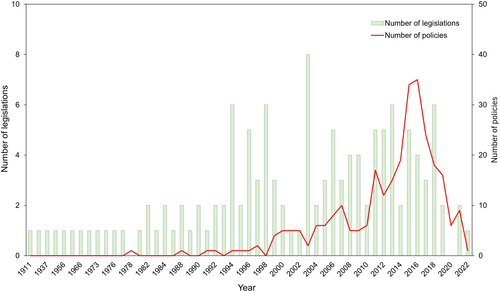
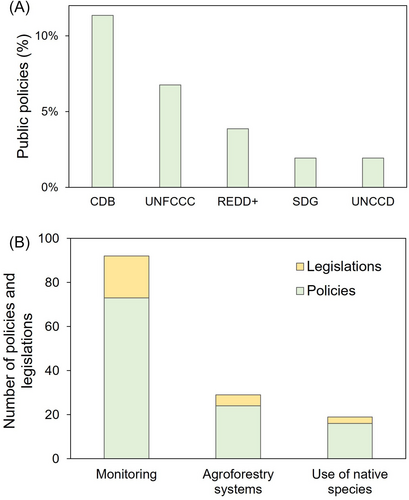
Forest Cover Loss
Based on the annual forest area loss from 2000 to 2020, we found that the FCL rate—calculated as the percentage of forest area lost relative to its extent in 2020—ranged from ≤1 to 30% across different countries (Table S2). Considering the FCL rate, the highest percentages were observed in Sierra Leone (30%), Malaysia (29%), Cameroon (28%), and South Africa (25%) (Fig. 3). Conversely, Nepal, Cambodia, South Sudan, Guyana, and Suriname exhibited the lowest rates, all equal to or below 1% (Fig. 3).
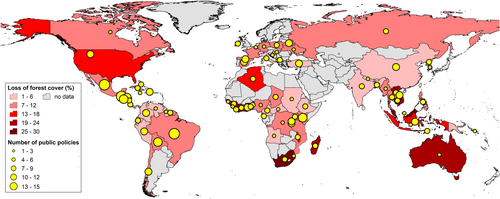
Human Development Index × Number of Public Policies and Forest Cover Loss
The number of public policies and rates of FCL varied little across HDI categories (Fig. 4A & 4B). However, our model demonstrated a significant positive relationship (p = 0.0313) between HDI categories and the number of public policies. FCL and HDI categories were not significantly related (p = 0.0572), similarly to the relationship between the number of public policies and FCL (p = 0.2559; Fig. 5).
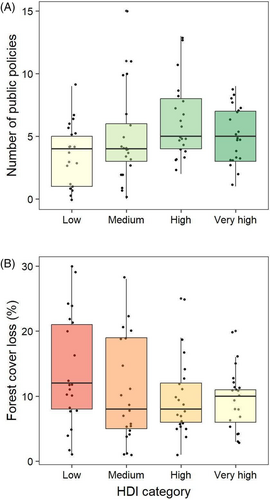

Discussion
In this review, we found that fewer than a third of public policies related to ecological restoration were designed to meet international commitments. This low percentage suggests a relatively low level of commitment toward international recommendations and best practices for ecological restoration, highlighting the need for stronger global influence to ensure restoration goals are met. Despite this, the timeline of our results is clear that the increasing number of laws regulating restoration since 1994 seems to reflect the impact of international agreements. For instance, as those resulting after the 1992 ECO-92 (Earth Summit in Rio de Janeiro), the United Nations Conference on Environment and Development (UNCED). During this conference, important frameworks, such as Agenda 21, were launched, and key conventions, including the Climate Change Convention and the Convention on Biological Diversity (CBD) were established (CBD 2020). These agreements have significantly shaped national policies (e.g., principle 7 of the 17 principles on global sustainable development explicitly assigning restoration as a responsibility for signatory states). After this, our results showed the highest peak in the number of laws enacted was in 2003. This may have been motivated by the World Summit on Sustainable Development (10 years after the first Earth Summit in Rio de Janeiro) which occurred in 2002. For instance, the bipartisan law, Healthy Forests Restoration Act (HFRA), that aims to reduce the risk of wildfires and restore healthy forests in the United States, was signed into law in 2003. The momentum continued with a next peak soon after the adoption of the Aichi Targets in 2010, particularly Target 15, which aimed to restore at least 15% of degraded ecosystems by 2020. The CBD's Global Biodiversity Outlook (GBO-5) report revealed that half of the countries set national restoration targets, with 17% achieving or surpassing the 15% goal. Similarly, the launch of the Bonn Challenge in 2011 set ambitious restoration targets, achieving the 2020 goal by 2017. Building on these successes, the Kunming-Montreal Global Biodiversity Framework, adopted in December 2022, sets an even more ambitious goal to restore 30% of degraded ecosystems globally by 2030.
We found that 22% of policies related to ecological restoration addressed monitoring of ecological restoration efforts. Monitoring is critical to measure restoration success, understand ecosystem impacts, and enable adaptive management to avoid failures (Hagger et al. 2017; Mazón et al. 2019; Zhang 2019). This legal requirement is essential, because if restoration is linked to incentive instruments, such as payments for environmental services and if there is no monitoring of this restoration process, any restoration action could lead to areas being considered successfully restored, even if the restoration has failed. Agroforestry was only mentioned in 7% of policies, even though it holds significant potential for reconciling agricultural production with biodiversity conservation and ecosystem service provision (Santos et al. 2019). However, policy improvements and better incentives are required to promote its adoption (Urruth et al. 2022). Finally, the limited focus on native species (5% of policies) is concerning, as their use enhances restoration success and sustainability (Assis et al. 2013). Conversely, reliance on non-native species can disrupt ecosystems through competition, altering soil properties, and nutrient cycles (Dodet & Collet 2012; Castro-Diez et al. 2019), especially if invasive species are introduced through the restoration process. Large-scale afforestation with non-native species poses additional risks to ecological integrity (D'Antonio & Meyerson 2002; Weidlich et al. 2020). Therefore, adhering to principles such as those outlined by the Society for Ecological Restoration (SER) underscores the importance of prioritizing native species in restoration efforts to align with ecological standards, enhance biodiversity, and ensure long-term sustainability.
The relationship between the number of public policies and FCL is often seen as negative, where countries with more policies tend to implement stronger measures to mitigate deforestation (Nepstad et al. 2014). For example, Mexico has 13 restoration policies and a relatively low forest loss rate of 8%, while Malaysia, which has only one policy, faces approximately 29% of total loss from 2000 to 2020. On the other hand, Nigeria and Canada, also with a single policy each, experience deforestation rates of approximately 10%, aligning more closely with the pattern observed in Mexico, despite having significantly fewer policies. However, this relationship is not always clear. For instance, some countries do not have many policies about restoration because their forest cover has already been recovered, and they do not see the need for implementing more policies, but it could be tested. Effective protection relies on integrating local engagement, proper planning, and a coordinated approach among various stakeholders, as studies show that efforts from both the government and non-government organizations that focus primarily on tree planting often fail without these components (Holl & Brancalion 2020). On the other hand, restoration policies linked to broader conservation efforts have been shown to effectively increase vegetation cover (Vina et al. 2016).
In countries such as Suriname and Guyana, significant areas of preserved native vegetation are present and deforestation rates are relatively moderate; the success of forest protection may stem from factors beyond legal frameworks (Boucher et al. 2017; Sassi et al. 2020). These countries often have lower population density, less agricultural expansion, and strong traditional land use practices that help maintain a balance between development and conservation (Haglund et al. 2011; Jose 2012). Additionally, their lower integration into global supply chains, such as those for palm oil or cattle ranching, reduces the pressure on their forests (Vina et al. 2016). Hence, while strong legal protections are crucial, a deeper understanding of local socio-economic factors and external pressures is essential for evaluating the effectiveness of forest conservation and restoration policies. Countries with lower deforestation rates, despite having fewer legal measures, may benefit from such contextual factors that should be considered in policy analysis.
Our model revealed a direct positive relationship between HDI and the number of public policies focused on restoration, indicating that as a country's development level increases, the number of policies aimed at ecological recovery also rises. This finding aligns with the literature suggesting that more developed countries possess higher scientific and institutional capacity to implement restoration actions (Weidlich et al. 2020). However, two exceptions are noteworthy. Guatemala, a country with a medium HDI (0.663), has the highest total number of public policies (n = 15), and Germany, with a very high HDI (0.947), has only two relevant policies for restoration. These cases suggest that the relationship between HDI and restoration policies is not linear, and that other factors, such as internal political issues, local priorities, and the stage of conservation policy development, may influence the number of policies implemented. The greater emphasis on restoration policies in more developed countries may reflect not only a stronger scientific basis, but also higher resource availability for implementing ecological recovery strategies. In contrast, in developing countries, the lack of updated information and data on the effectiveness of restoration policies may be one of the factors hindering the implementation of effective policies, contributing to the lag in restoration actions in countries with lower HDI (Weidlich et al. 2020). These exceptions and variations suggest that although HDI is an important factor, it is not the sole determinant for the number of restoration-related public policies, and a deeper understanding of local contexts and socioeconomic conditions is needed to grasp the dynamics that drive the formulation of these policies.
We initially expected that more developed countries would have lower rates of FCL, as poverty and income inequality are commonly associated with higher rates of pollution and deforestation (FAO 2022). This pattern was observed in countries such as Australia (HDI 0.944) and Sierra Leone (HDI 0.452), both with relatively high FCL (20 and 30%, respectively). However, this pattern was not universal, suggesting that other factors, such as extreme climate events, may be influencing FCLes. For example, in Australia, recent forest fires exacerbated by climate change show that forest loss may not be directly aligned with HDI, especially when catastrophic events, such as wildfires, are taken into account (Lipsett-Moore et al. 2018; Murphy et al. 2018; Driscoll et al. 2024). Hence, it is important to highlight that these fires do not seem to be related to HDI, as climate change and extreme weather events are happening no matter what the HDI of the country.
In biodiversity hotspots, high population growth combined with low HDI is linked to higher deforestation rates. However, when HDI is high, deforestation rates remain low, even with high population growth (Jha & Bawa 2006). In these cases, policy choices that disregard conservation can lead to deforestation, even in relatively developed countries (Jha & Bawa 2006). Additionally, most biodiversity hotspots are located in developing countries, where ecosystem restoration efforts must be aligned with socio-economic development initiatives to gain local support and ensure long-term sustainability and conservation (Aronson et al. 2006). Therefore, FCL cannot be explained solely by economic development and HDI. Other factors, such as soil and subsoil richness, land tenure structures, and cultural influences, also play critical roles (Groot et al. 2020; Chheang et al. 2021), as well as climate change due to massive wildfire effects (Linley et al. 2022; Driscoll et al. 2024).
For instance, Buddhism is widely practiced in Cambodia, and the relatively low deforestation rates in this country are partly due to cultural and religious values that emphasize harmony with nature and the protection of sacred forests (Scheer 2021). Similarly, Nepal, where Hinduism is the predominant religion, also exhibits low deforestation rates, reflecting how traditional land use practices and religious beliefs can contribute to more sustainable land management, even in countries with lower HDI (Mahaseth & Shukla 2021). These cultural factors, along with the unique characteristics of each country's soil, land ownership structures, and historical land use practices, provide valuable insights into why countries like Cambodia, despite their lower HDI, may demonstrate more effective forest conservation than expected. Furthermore, countries with low forest vegetation loss rates in recent decades may have already deforested large areas in the past and have since stabilized their forest cover through reforestation or natural regeneration efforts, which help balance forest vegetation loss.
International agreements are important for global restoration and incentivize decision makers to achieve restoration goals. The level of development of a country can influence the development and the number of public policies aimed at restoration. Nevertheless, to reverse vegetation cover loss, proper planning and monitoring are necessary. Stakeholder consultations are essential with all parties involved, including public and private governance, as well as the broader community. Additionally, incentives are necessary, as policies promoting the use of local biodiversity in restoration efforts are crucial to mitigate the risk of invasive species that could hinder the restoration process. Understanding the relationship between public policies and human development can contribute to the success of ecological restoration, as policies can serve as an incentive to expand biodiverse agroecological practices that facilitate the restoration of native species and increase food production managed in a sustainable manner. Finally, further studies may investigate if, even if public policies are few in some countries, they may be effective. Hence, with effective public policies, we will be able to achieve the goals of the international agreements on restoration.
Acknowledgments
The Coordenação de Aperfeiçoamento de Pessoal de Nível Superior—Brasil (CAPES) provided essential financial support via grants (Finance Code 001) to L.O.P. L.C.G. is grateful to the CNPq (grant 310963/2023-0). We thank Dr. J. M. O. Quintero, Dr. L. M. Barbosa, Dr. M. A. de Goes Calmon, and D. B. Provete for their comments on earlier drafts of this manuscript. B.H.S.F. and L.C.G. thanks the “Capital Natural: Biodiversidade e Serviços Ecossistêmicos nas paisagens do Pantanal” CNPq (grant number 441181/2023-6). The Article Processing Charge for the publication of this research was funded by the Coordenação de Aperfeiçoamento de Pessoal de Nível Superior - Brasil (CAPES) (ROR identifier: 00x0ma614).



